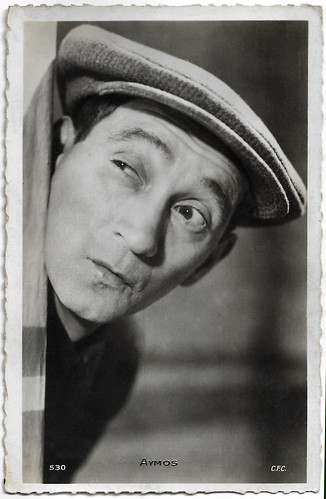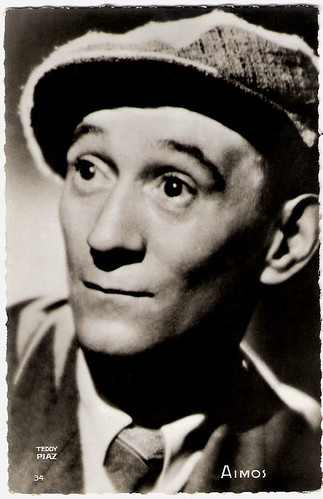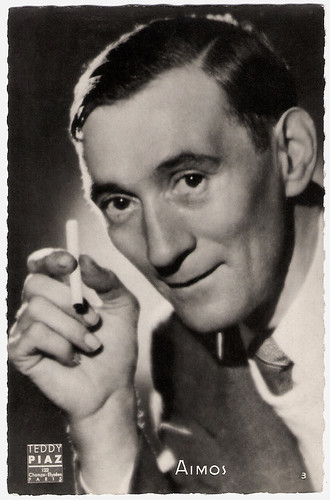Character actor Raymond Aimos (1891–1944) or simply Aimos was one of the familiar faces of the French cinema of the 1930s and early 1940s. During this golden age of poetic realism, he was the quintessential 'Titi Parisien' (Parisian kid) in at least 105 films. His film characters generally corresponded with himself: humble, poor, colourful, cheeky but with a heart of gold.

French postcard, no. 530. Photo: C.F.C.

French postcard by Editions P.I., Paris, no. 34. Photo: Teddy Piaz.
Raymond Aimos was born as Raymond Arthur Caudrilliers in La Fère, in the Aisne department in the North of France in 1891 (1889 (sic) according to IMDb, English Wikipedia, and other sources, who also erroneously write that his birth name is Raymond Coudurier). He was the son of a watchmaker-jeweler and was expected to work in the family business but young Raymond was uncontrollably attracted to show business.
He managed to become an opera singer under the stage name Aimos. According to urban legends, retold by different sources, he made his first film appearance as a kid either in the Lumière brothers’ L’arroseur arose/The Sprinkler Sprinkled (Louis Lumière, 1895) or in a film by another legendary film pioneer, Georges Méliès. (In the first film, the naughty boy was Benoît Duval).
However, officially Aimos made his cinema debut in the short silent Western Pendaison à Jefferson City/Hanging at Jefferson City (Jean Durand, 1910) with Joë Hamman and Gaston Modot.
He appeared in more early silent shorts, like the Onesime comedies Onésime et le nourrisson de la nourrice indigne/ Onesimus and the infant unworthy of the nurse (Jean Durand, 1912), Onésime a un duel à l'américaine/Onesime has an American-style duel (Jean Durand, 1912) and Onésime horloger/Onesime, Clockmaker (Jean Durand, 1912), all starring Ernest Bourbon aka Onésime.
A decade later, Aimos appeared in The Three Musketeers-sequel Vingt Ans après/Five Years Later (Henri Diamant-Berger, 1922), based on the novel by Alexandre Dumas père. These film parts had all been modest, but Aimos’ lucky strike would be the coming of sound.

French postcard by Editions P.I., Paris, no. 123 Photo: Star.
Aimos' physical appearance, his popular roots and mostly his gift of gab were in perfect harmony with the sound cinema of the 1930s. He was wonderful as a humble man of the people in two masterpieces by René Clair, Sous les toits de Paris/Under the Roofs of Paris (1930) starring Albert Préjean, and Quatorze juillet/July 14 (1933) with Annabella.
It lead to more work for important directors. He appeared for Raymond Bernard as a soldier in the war drama Les croix de bois/Wooden Crosses (1932) with Pierre Blanchar, and a clochard in Amants et voleurs/Lovers and Thieves (1935) with Arletty, for Sacha Guitry as another clochard in Ils étaient neuf célibataires/Nine Bachelors (1939), for Marcel Carné as Quart-Vittel, the wreck in Quai des brumes/Port of Shadows (1938), and for Jean Grémillon in Lumière d'été/Summer Light (1943) starring Madeleine Renaud.
His most memorable roles were in the films by Julien Duvivier, such as Mulot, the legionary friend of Jean Gabin in La Bandera/Escape from Yesterday (1935), and Tintin, one of the five friends who build a riverside café after winning the jackpot in the lottery in La Belle Équipe/They Were Five (1936) with Jean Gabin and Charles Vanel. He also appeared in Duvivier’s Le paquebot Tenacity/S.S. Tenacity (Julien Duvivier, 1934) with Albert Préjean, and L’homme du jour/The Man of the Hour (Julien Duvivier, 1937) starring Maurice Chevalier.
At IMDb, Guy Bellinger writes: “But even when he worked for less distinctive directors his presence was an asset for the film.” Some of these films now belong to the highlights of the Poetic realism, a French genre of the 1930s of lyrical, stylized and studio-bound films which offered a fatalistic view of life with their characters living on the margins of society, either as unemployed members of the working class or as criminals.
Raymond Aimos was a courageous man with a big heart in life. In 1940, he opened a restaurant in the Rue Montmartre in the capital, 'L'Oeuvre des Gosses d'Aimos', intended to feed the poor children of the neighbourhood. In August 1944, he decided to take part in the uprising against the Nazis which would lead to the Liberation of Paris.
He was unfortunately hit by a stray bullet in the 10th Arrondissement. The exact circumstances of his death remain unclear and undetermined. He was only 53. Aimos is buried in the cemetery of Chennevières-sur-Marne (Val-de-Marne).
Raymond Aimos was married to Madeleine Botté from 1923 till their divorce in 1938. They had no children. But he left an impressive film legacy, according to some sources he even appeared in nearly 450 films! (IMDb only mentions 109 films).

French postcard by Editions O.P., Paris, no. 3 Photo: Teddy Piaz, Paris.

Belgian postcard by P.E. (Photo Édition, Bruxelles), no. 17. Photo: Studio Melvyle.
Sources: Simon Benattar-Bourgeay (Ciné-Artistes - French), Yvan Foucart (L'encinémathèque - French), Guy Bellinger (IMDb), Wikipedia (French and English) and IMDb.

French postcard, no. 530. Photo: C.F.C.

French postcard by Editions P.I., Paris, no. 34. Photo: Teddy Piaz.
Urban Legends
Raymond Aimos was born as Raymond Arthur Caudrilliers in La Fère, in the Aisne department in the North of France in 1891 (1889 (sic) according to IMDb, English Wikipedia, and other sources, who also erroneously write that his birth name is Raymond Coudurier). He was the son of a watchmaker-jeweler and was expected to work in the family business but young Raymond was uncontrollably attracted to show business.
He managed to become an opera singer under the stage name Aimos. According to urban legends, retold by different sources, he made his first film appearance as a kid either in the Lumière brothers’ L’arroseur arose/The Sprinkler Sprinkled (Louis Lumière, 1895) or in a film by another legendary film pioneer, Georges Méliès. (In the first film, the naughty boy was Benoît Duval).
However, officially Aimos made his cinema debut in the short silent Western Pendaison à Jefferson City/Hanging at Jefferson City (Jean Durand, 1910) with Joë Hamman and Gaston Modot.
He appeared in more early silent shorts, like the Onesime comedies Onésime et le nourrisson de la nourrice indigne/ Onesimus and the infant unworthy of the nurse (Jean Durand, 1912), Onésime a un duel à l'américaine/Onesime has an American-style duel (Jean Durand, 1912) and Onésime horloger/Onesime, Clockmaker (Jean Durand, 1912), all starring Ernest Bourbon aka Onésime.
A decade later, Aimos appeared in The Three Musketeers-sequel Vingt Ans après/Five Years Later (Henri Diamant-Berger, 1922), based on the novel by Alexandre Dumas père. These film parts had all been modest, but Aimos’ lucky strike would be the coming of sound.

French postcard by Editions P.I., Paris, no. 123 Photo: Star.
Highlights of the Poetic realism
Aimos' physical appearance, his popular roots and mostly his gift of gab were in perfect harmony with the sound cinema of the 1930s. He was wonderful as a humble man of the people in two masterpieces by René Clair, Sous les toits de Paris/Under the Roofs of Paris (1930) starring Albert Préjean, and Quatorze juillet/July 14 (1933) with Annabella.
It lead to more work for important directors. He appeared for Raymond Bernard as a soldier in the war drama Les croix de bois/Wooden Crosses (1932) with Pierre Blanchar, and a clochard in Amants et voleurs/Lovers and Thieves (1935) with Arletty, for Sacha Guitry as another clochard in Ils étaient neuf célibataires/Nine Bachelors (1939), for Marcel Carné as Quart-Vittel, the wreck in Quai des brumes/Port of Shadows (1938), and for Jean Grémillon in Lumière d'été/Summer Light (1943) starring Madeleine Renaud.
His most memorable roles were in the films by Julien Duvivier, such as Mulot, the legionary friend of Jean Gabin in La Bandera/Escape from Yesterday (1935), and Tintin, one of the five friends who build a riverside café after winning the jackpot in the lottery in La Belle Équipe/They Were Five (1936) with Jean Gabin and Charles Vanel. He also appeared in Duvivier’s Le paquebot Tenacity/S.S. Tenacity (Julien Duvivier, 1934) with Albert Préjean, and L’homme du jour/The Man of the Hour (Julien Duvivier, 1937) starring Maurice Chevalier.
At IMDb, Guy Bellinger writes: “But even when he worked for less distinctive directors his presence was an asset for the film.” Some of these films now belong to the highlights of the Poetic realism, a French genre of the 1930s of lyrical, stylized and studio-bound films which offered a fatalistic view of life with their characters living on the margins of society, either as unemployed members of the working class or as criminals.
Raymond Aimos was a courageous man with a big heart in life. In 1940, he opened a restaurant in the Rue Montmartre in the capital, 'L'Oeuvre des Gosses d'Aimos', intended to feed the poor children of the neighbourhood. In August 1944, he decided to take part in the uprising against the Nazis which would lead to the Liberation of Paris.
He was unfortunately hit by a stray bullet in the 10th Arrondissement. The exact circumstances of his death remain unclear and undetermined. He was only 53. Aimos is buried in the cemetery of Chennevières-sur-Marne (Val-de-Marne).
Raymond Aimos was married to Madeleine Botté from 1923 till their divorce in 1938. They had no children. But he left an impressive film legacy, according to some sources he even appeared in nearly 450 films! (IMDb only mentions 109 films).

French postcard by Editions O.P., Paris, no. 3 Photo: Teddy Piaz, Paris.

Belgian postcard by P.E. (Photo Édition, Bruxelles), no. 17. Photo: Studio Melvyle.
Sources: Simon Benattar-Bourgeay (Ciné-Artistes - French), Yvan Foucart (L'encinémathèque - French), Guy Bellinger (IMDb), Wikipedia (French and English) and IMDb.
1 comment:
I just stumbled upon your blog and wanted to say that I?ve really enjoyed browsing your blog posts. In any case I will be subscribing to your feed and I hope you write again very soon.
Post a Comment